The Great Lakes Basin Railroad From Start To Nowhere Near Finish
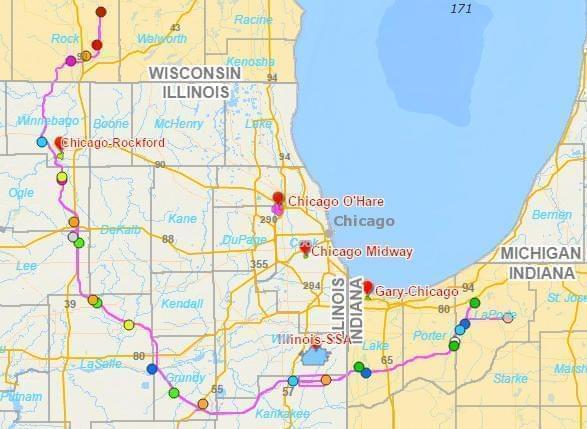
Proposed path of the Great Lakes Basin Railroad Great Lakes Basin Transportation / greatlakesbasin.net
What’s the Great Lakes Basin Railroad and why should I care?
The GLBR is a proposed railway that, if you live in northern Illinois, southern Wisconsin, or northwest Indiana, you’ve either never heard of or have spent a lot of time learning about over the last year.
Under the current route proposal, the Great Lakes Basin Railroad would enter Kankakee County, Illinois, just below the Will County line, traveling west-southwest to enter Grundy County a couple of miles above its southern boundary.
The route then angles northwest and enters LaSalle County at roughly the southern border of Kendall County, heading northwest into Lee County about two miles west of the DeKalb County line. It goes north to parallel Interstate 39 to just north of Rochelle in Ogle County, where it jogs west and heads up into Winnebago County just west of the Chicago Rockford International Airport.
The route then meanders through western Winnebago County into Rock County, Wisconsin, less than 10 miles west of Beloit. It crosses Interstate 90/39 a few miles north of Beloit and then heads north to a point east of Milton where it would join the Wisconsin and Southern Railroad, which provides connections to Milwaukee.
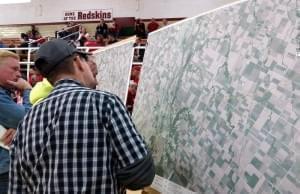
Examining maps of the proposed railroad in Morris, IL, May, 2016
Simply put, it’s a big ring around the Chicago area, way outside Chicago. There would be a 15-thousand acre rail port near Manteno, not far from the proposed “Third Chicago Airport” in Peotone. The reason this rail runs so far out beyond the Chicago suburbs is to avoid the traffic. That’s the point. The Great Lakes Basin Railroad would route traffic around Chicago-area congestion while creating connections for other railroads that want to move faster within the region. This is not about commuter rail.
Who’s behind it?
It’s the brainchild -- and dream -- of Frank Patton. He lives in Will County, is a former computer programmer, and founded a software company serving the financial industry. The Great Lakes Basin railroad started as an idea to run a toll railway along the proposed Illiana Expressway, which was supposed to relieve highway congestion. The Illiana was eventually tabled, and Patton started looking at other ways to relieve rail back-ups in Chicago. He founded Great Lakes Basin Transportation five years ago and partnered with Jim Wilson, who has experience in operations for Santa Fe Railroad. What they’ve come up with is a 260 mile, $8 billion project. They want to reduce freight rail travel time in the Chicago area from 30 hours to 8. Frank Patton says “This is a plan that according to people who understand the process, and what could end up after it’s built, could have a huge impact on the economy of region, on successive generations.”
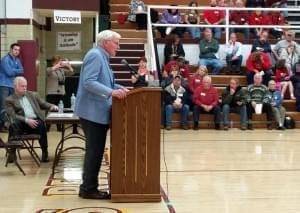
Frank Patton speaks to a raucous crowd at Morris High School.
$8 billion? Who’s going to pay for this project?
Patton says it’s privately funded. He won’t say who the investors are because he says he has non-disclosure agreements with them. The company insists taxpayers won’t get stuck paying for anything.
This is the third iteration of this route. How was it chosen and why the changes?
Patton says there are three criteria for the route: It can’t cross through heavily populated areas; there has to be a connection with the tracks belonging to all six of the major rail companies going in and out of Chicago; and they need to stay away from wetlands. The problem is that there are a lot of potential obstacles along the way: wetlands, cemeteries, four major rivers, and a lot of angry residents -- especially farmers. They made their voices heard, quite loudly and clearly, at public meetings earlier this year.
Opposition from town governments and homeowners along a route that would have entered Wisconsin east of Rockford, from Boone County, helped push the GLBR onto a new path in September. The current route, any route, would need a lot of fine-tuning before this thing gets built.
There’s a lot of opposition?
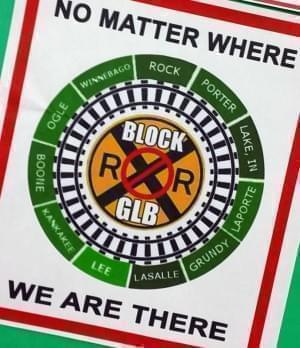
Anti-GLBR groups are unified.
Oh, yes. Rock Against the Rail, Block GLB, RAILED, Citizens Against the GLB Railroad … Thousands of well-organized people have planted signs in their yards, called their Congressmen, shared endless amounts of information on social media and, most importantly, filed their comments objecting to the project with the Surface Transportation Board.
What’s that?
The STB is part of U.S. Department of Transportation. It’s in the process of preparing a review of the environmental impact of this project. It takes about two years. They’ve held public meetings and have gathered thousands of comments on their website from residents, businesses, organizations, and governments. The communications with the STB are available for everyone to see on their website.
What’s in it for the landowners?
They get $20,000 an acre, according to Patton. But you have to realize that their land would be purchased in strips 200 feet wide. So they’ll have to do some serious math to figure out how much they’d get for selling their land. (A strip that wide and not quite 220 feet long is an acre.) If they refuse to sell, there’s a chance they’d get a lot less for it after the legal process. In this region, land outside heavily populated areas is very often farmland, and farmers don’t appreciate being told their livelihoods are less important than others. That’s one reason that state Farm Bureaus object. Some farms would be bisected. Barb Beeler owns a farm near Beloit, Wisconsin, and has a little restaurant where she serves her farm-raised meats. The rail line is on track to cut through her farm, near the restaurant, cutting off access to pasture for some of her animals. She says she won’t be able to afford to feed them if that happens. Beeler says it’s frustrating not knowing for two years if she will have a train in her backyard.
As for landowners, Frank Patton has also promised free electricity to homeowners along the route and the potential for personal rail access, which might be appealing to businesses or very large farms.
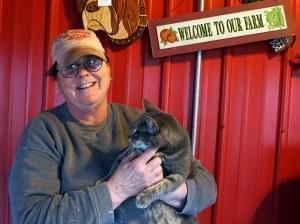
Barb Beeler and friend, at the Double B Cafe in Beloit
Wait. Free electricity? How?
The company isn’t saying how or why, just that it will supply free electricity to the landowners and their immediate heirs, to one home on land connected to the right-of-way. As you can imagine, opponents are skeptical. And it also spurs speculation that the company wants these 200-foot-wide right-of-ways for more than a train: Opponents want to know if the land they sell will be used for other purposes, such as power lines or oil and gas pipelines.
Why not use existing rail lines? There are tracks everywhere around the region.
The company says using existing 19th century railroad beds would route their railroad through population centers, which defeats their purpose. There’s an alternative that opponents of this project point to: an organization called CREATE. It’s a coalition started in 2003 involving the U.S. and Illinois Departments of Transportation, the City of Chicago, regional passenger rail lines, and national freight rail companies. They are spending billions improving existing rail corridors and crossings to speed up freight and passenger rail. Supporters of the Great Lakes Basin Railroad say it will enhance CREATE’s efforts.
What’s next?
The public comment period ended in June, but the most recent route changes were announced in September: people can still send their comments to the Surface Transportation Board. The Board’s Office of Environmental Analysis is reviewing the project. Meanwhile, Great Lakes Basin Transportation wants to suspend the environmental review so it can focus on its entire application. They plan to file their application to build the railroad sometime next year and Patton has stated he wants to start building in 2018. Meanwhile, opponents are asking the government to hold more public meetings because of the route change.
- Tuesday, in part-two of this series, we'll hear some of the environmental questions raised by the Great Lakes Basin Railroad proposal.
Links
- Residents Divided Over Proposed Railroad Project; Can Horses Help Treat Trauma?; Cold Weather
- New Short Line Railroad Announced For Decatur
- ADM Opens Rail-Based Container Hub
- High Speed Rail Project on Track to Be Completed
- U. of Illinois to Get New Rail Center
- Illinois Gets $186 Million for Rail Project

